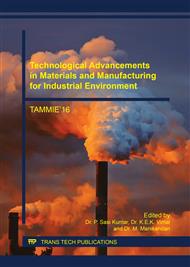p.64
p.73
p.81
p.88
p.97
p.105
p.112
p.119
p.127
Process Parameters Optimization of Friction Stir Welding in Aluminium Alloy 6063-T6 by Taguchi Method
Abstract:
This paper deals with the effective application of friction stir welding similar to butt joining technique.AL6063 T-6 alloys prepared in 125x 100 x 7mm thickness plate and FSW tool setup were H13 of diameter 25mm rotary tool with straight cylindrical pin profile. The maximum strength was considered for selection of combined process parameter. The process parameters were optimized using Taguchi method. The Rotational speed, welding speed, and axial speed are the main process parameter which taken into our consideration. The optimum process parameters are determined with reference to tensile strength of the joint. From the experiments, it was found the effects of welding parameter are the axial force is highest substantial parameter to determining the tensile strength of the joint. The paper which revealed the optimal values of process parameter are to acquire a maximum tensile strength of friction stir welded AL6063-T6 plates is 101.6Mpa with the combination level of rotational speed, welding speed and axial force are found to be 1100 RPM, 60 mm/min and 12.5 KN. validation test was carried out and results were nearer to the optimized results confirmed by the optimum results.
Info:
Periodical:
Pages:
97-104
Citation:
Online since:
July 2017
Authors:
Price:
Сopyright:
© 2017 Trans Tech Publications Ltd. All Rights Reserved
Share:
Citation:


